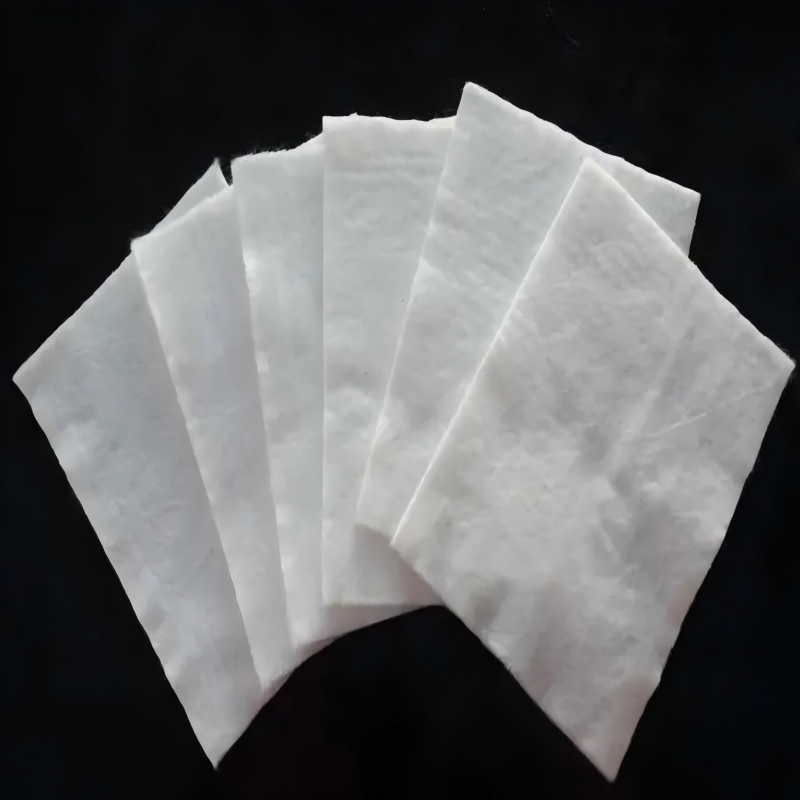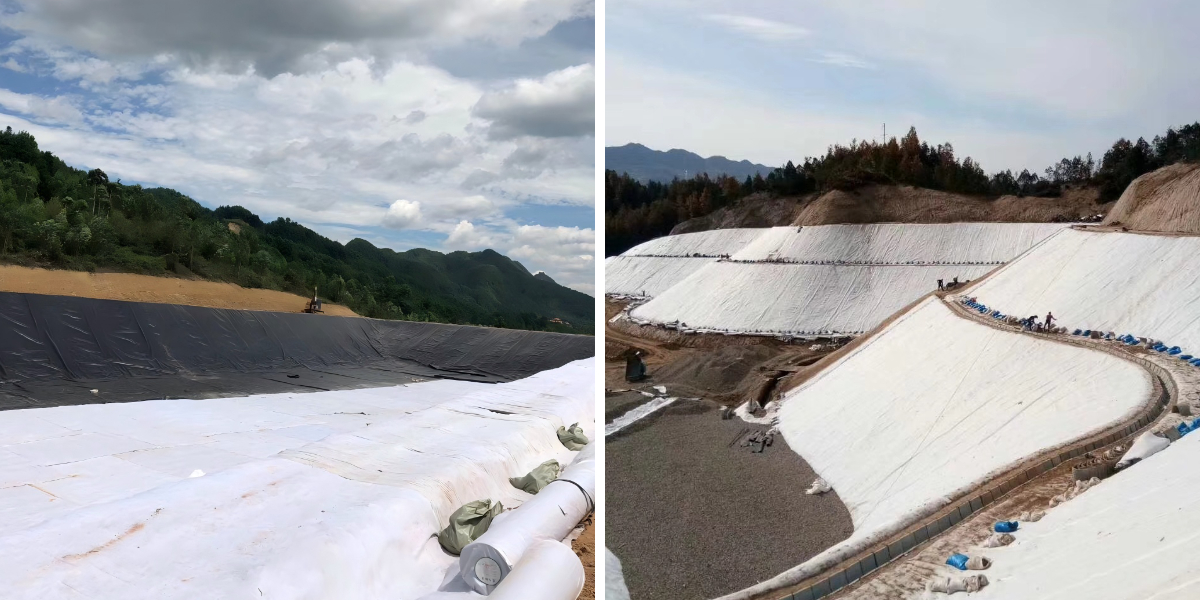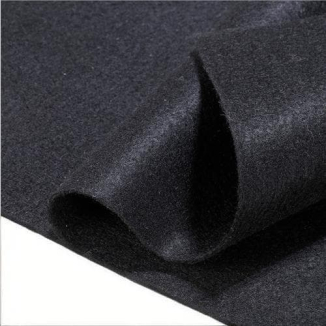Geotech Fabric Retaining Wall
1. Reinforcement and soil consolidation: Enhance the integrity of the wall and backfill soil, disperse lateral pressure, prevent overturning and cracking, and improve structural stability.
2. Filtration and moisture prevention: Drain accumulated water to reduce pore water pressure, prevent fine soil loss, and prevent wall instability due to water erosion.
3. Flexible adaptation: conforms to terrain and irregular walls, adapts to settlement deformation, and is more impact resistant than rigid structures.
4. Labor saving economy: Easy to lay, reduce the use of building materials, fast construction, low cost, compatible with ecological greening needs.
Products Introduction:
Geotech Fabric Retaining Wall is a flexible retaining structure constructed with high-strength geotextile as the core reinforcement material, combined with backfill soil and panels (such as concrete blocks and ecological bags). The core principle is to convert the lateral soil pressure behind the wall into the axial tension of the geotextile through the tensile properties of the geotextile and the frictional effect of the backfill soil, thereby balancing the load and stabilizing the slope. Compared with traditional rigid retaining walls such as masonry and reinforced concrete, it is characterized by "flexible stress, ecological compatibility, and convenient construction", and is suitable for scenarios such as filling slopes, road shoulders, and site leveling. It can effectively solve the problem of soil instability caused by terrain height differences, while reducing engineering costs and ecological impacts.
Product Features:
1. Flexible reinforcement with strong deformation resistance: Woven or composite geotextiles with a fracture strength of 10-80kN/m are used as reinforcement materials, which are tightly interlocked with backfill soil to form a "reinforcement soil" composite structure. When subjected to force, it can disperse the load through its own deformation, adapt to slight settlement of the foundation (allowing settlement up to 50mm), avoid common cracking and overturning problems of rigid walls, especially suitable for complex geological conditions such as soft soil foundation.
2. Integrated filtration and drainage system to prevent water accumulation and instability: Geotextiles have both filtration and drainage functions, which can intercept fine particles in backfill soil (retention rate>95%) and prevent soil erosion from causing wall voids; It can also quickly divert rainwater and groundwater, reduce the pore water pressure of backfill soil, avoid wall sliding caused by water accumulation and weight gain, and maintain structural stability in the long term.
3. Ecological compatibility and excellent landscape: The wall panels can be made of materials such as ecological bags and plant-based concrete. The geotextile itself is breathable and permeable, providing a carrier for vegetation growth. In the later stage, the vegetation root system penetrates the reinforcement material and interweaves with the soil, forming a "plant structure" symbiotic system, which not only strengthens the protective effect but also restores the natural landscape, solving the problem of "ecological fragmentation" of traditional retaining walls.
4. Efficient and economical, low construction difficulty: No need for large lifting equipment, geotextile rolls can be manually laid, panel modular assembly, daily construction can reach 100-300 square meters, with an efficiency increase of more than 40% compared to rigid retaining walls. Low material usage (only 1/5 of steel reinforcement), overall cost reduction of 20% -50%, and easy maintenance in the later stage. Local damage can be quickly repaired.
Product Parameters:
project | metric | ||||||||||
Nominal strength/(kN/m) | |||||||||||
6 | 9 | 12 | 18 | 24 | 30 | 36 | 48 | 54 | |||
1 | Longitudinal and transverse tensile strength / (kN/m) ≥ | 6 | 9 | 12 | 18 | 24 | 30 | 36 | 48 | 54 | |
2 | Maximum elongation at maximum load in longitudinal and transverse directions/% | 30~80 | |||||||||
3 | CBR top penetration strength /kN ≥ | 0.9 | 1.6 | 1.9 | 2.9 | 3.9 | 5.3 | 6.4 | 7.9 | 8.5 | |
4 | Longitudinal and transverse tearing strength /kN | 0.15 | 0.22 | 0.29 | 0.43 | 0.57 | 0.71 | 0.83 | 1.1 | 1.25 | |
5 | Equivalent aperture O.90(O95)/mm | 0.05~0.30 | |||||||||
6 | Vertical permeability coefficient/(cm/s) | K× (10-¹~10-), where K=1.0~9.9 | |||||||||
7 | Width deviation rate /% ≥ | -0.5 | |||||||||
8 | Unit area mass deviation rate /% ≥ | -5 | |||||||||
9 | Thickness deviation rate /% ≥ | -10 | |||||||||
10 | Thickness coefficient of variation (CV)/% ≤ | 10 | |||||||||
11 | Dynamic perforation | Puncture hole diameter/mm ≤ | 37 | 33 | 27 | 20 | 17 | 14 | 11 | 9 | 7 |
12 | Longitudinal and transverse fracture strength (grab method)/kN ≥ | 0.3 | 0.5 | 0.7 | 1.1 | 1.4 | 1.9 | 2.4 | 3 | 3.5 | |
13 | Ultraviolet resistance (Xenon arc lamp method) | Longitudinal and transverse strength retention rate% ≥ | 70 | ||||||||
14 | Ultraviolet resistance (fluorescence UV lamp method) | Longitudinal and transverse strength retention rate% ≥ | 80 | ||||||||
Product Applications:
1. Road and municipal engineering: Applied in the filling shoulder and slope support of highways and railways, using flexible structures to adapt to vehicle vibration loads and reduce the impact of roadbed settlement on roads. For example, at the bends of mountainous roads, traditional retaining walls can be used to shrink the foot of the slope, saving land and reducing construction difficulty.
2. Site leveling and park construction: Used for the treatment of site height differences in industrial parks and residential areas. Through layered backfilling and geotextile reinforcement, a stable flat space is quickly formed. Paired with ecological panels, it can create landscape barriers that meet the needs of park greening and aesthetics.
3. River and Water Conservancy Engineering: Used in the support of river bank slopes and reservoir dam shoulders to resist water flow erosion and soil pressure, while planting aquatic plants through ecological bag panels to balance flood control and river ecological restoration, suitable for urban waterfront management.
4. Mining and slope restoration: For the high and steep slopes after mining, geotextile retaining walls are used for layered reinforcement, combined with spray greening to achieve the integration of "support and greening", prevent landslides and collapses, and assist in the ecological restoration and acceptance of the mine.
The Geotech Fabric Retaining Wall, with its core advantages of "flexible force bearing, ecological compatibility, and economic efficiency," has broken through the limitations of traditional rigid retaining walls in complex geological and ecologically sensitive areas. Through the synergistic effect of geotextiles and soil, it can stabilize terrain with height differences, adapt to environmental changes, and balance engineering safety and ecological value. Whether it is conventional road and municipal support, or ecological restoration of mining waterways, this structure can meet diverse needs with the characteristics of low cost and fast construction, becoming an ideal choice for balancing "functionality, economy, and ecology" in modern geotechnical engineering, and promoting the development of retaining wall technology towards a more sustainable direction.













